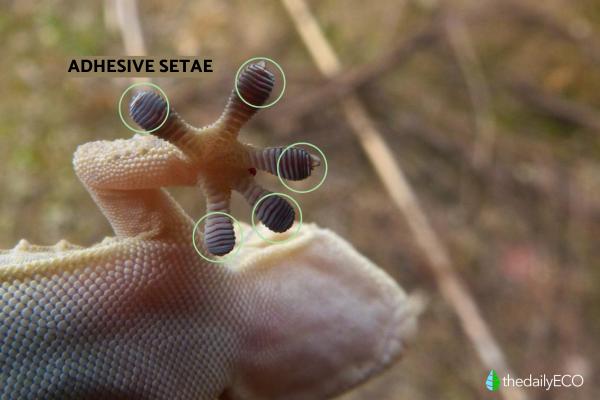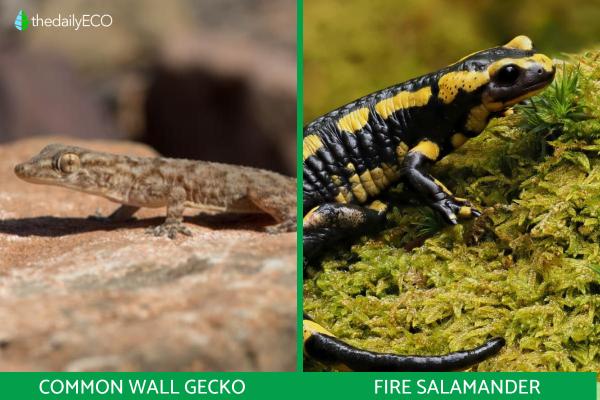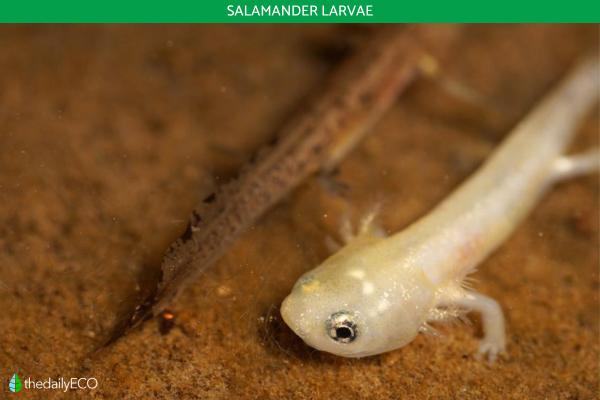Salamander vs. Gecko Differences


Salamanders and geckos are both small vertebrates which look quite similar at a distance. Both have a very similar body conformation, insectivorous diet and nocturnal habits. Although they look similar, they are actually very different. Even if they may both look like lizards, only one falls into this category of animal. They are two very different species without any close taxonomic relationship. If you have ever wanted to identify the salamander vs. gecko differences, we make this comparison with photos to see what they are for yourself.
Salamander vs. gecko taxonomic differences
To make a comparison about the differences between salamanders and geckos, we should start with how they are classified scientifically. This refers to their taxonomic organization, the ways in which all animals are grouped for comparison purposes. We look at two example species:
- Common wall gecko (Tarentola mauritanica): a type of lizard belonging to the Phyllodactylidae family. All the animals known as geckos are from this family which are a type of reptile.
- Fire salamander (Salamandra salamandra): all salamanders belong to the order Urodela. This specific species belongs to the family Salamandridae, making them a type of amphibian. They are the most common species of salamander in Europe,
From the outset we find differences between these two species because they belong to different classes. Let's review four of them:
- Skin: reptiles like the gecko have hard, dry skin with keratinous scales. The skin of amphibians is thin, warty, smooth, moist and permeable. Geckos shed their skin periodically, salamanders do not.
- Breathing: reptiles breathe only through their lungs. Amphibians have a respiratory system which can change as they develop. Some breathe through through gills in the early stages of their life, doing so through lungs and integument in the adult stage. This means adult salamanders can also breathe through their skin. Some salamanders such as axolotls also have gills in adult stages.
- Eggs: reptiles lay hard-shelled amniotic eggs, which makes their reproduction independent of bodies of water. Amphibians have soft eggs, depending on bodies of water to avoid drying out.
- Urine: amphibians eliminate nitrogenous compounds through urine in the form of ammonia. Reptiles do so in the form of uric acid. This is because nitrogenous compounds require dilution in large amounts of water before they can be eliminated. Reptiles have developed the ability to eliminate through uric acid strategy to avoid water loss, something especially important for reptiles living in very arid areas.
Learn the differences between other types of reptile with our article on the differences between alligators and crocodiles.

Salamander vs. gecko morphology
One of the reasons we provide a comparison between a salamander vs. gecko differences is due to their physical similarities. Taking a closer look at this two animals, we can see they actually have some very particular morphological differences. They include:
- Size: it is true there are certain species of gecko and salamander which can be around the same size. This is particularly the case during different periods of development. However, geckos are generally larger than salamanders. Most salamanders average around 6" in length, geckos usually average around 10". However, the longest extant gecko is the New Caledonia giant gecko (Rhacodactylus leachianus) which measures up to 17", but the largest salamander is the South China giant salamander (Andrias sligoi) which has been recorded at an immense 5.9 feet.
- Legs: while most salamander species have legs, there are various limbless salamanders. While there are a very few legless reptiles, all gecko species have legs.
- Feet: although some species are more nimble than others, gecko feet are very specifically adapted to climbing vertically. This is thanks to their specially adapted feet which have millions of tiny hair-like structures known as setae (see photo above). They can climb various surfaces easily and hang upside down without any problem. Salamanders can also climb at inclinations, but they are nowhere near as adept as geckos[1].
- Eyes: with very few exceptions, geckos do not have eyelids. Salamanders have effective and very movable eyelids.
- Coloration: both geckos and salamanders can have various colorations of their skin. However, the patterns and presentation of colors are very different. This is due to the gecko having scales and the salamander having a moist skin. Many different salamander species have biofluorescence, meaning they can reflect fluorescent light. This is not found often in geckos with only one species known to show some biofluorescent properties[2].
- Integument: the gecko has a body covered with scales and its tail is spiny. The salamander has smooth, shiny, moist skin and glandular pores all over its body. You can see this difference in skin with the photo below.

Salamander vs. gecko distribution and habitat
Another difference between the gecko and the salamander is based on their distribution and habitat:
- Salamander: while we can now find salamanders in other places, species are largely native to areas in the Northern Hemisphere. No species are native to sub-Saharan Africa or Australia, although there are South Asian salamander species. Most are located in North and Central America.
- Gecko: geckos have a distribution which is almost the opposite of salamanders. Although they can be found on all continents except for Antarctica, their population distribution is more skewed towards the Southern Hemisphere. There are nonnative species in parts of the US, although these tend to be more around the southernmost states.
Both geckos and salamanders have terrestrial habits, but many salamanders are also semi-aquatic. All salamanders require bodies of water for reproduction, even if there is some variation in how this is carried out. Geckos generally live in arid areas where they live on rocks and cliffs. It is also common for geckos to live in and around human settlements. They are often seen scuttling along the walls of various buildings.
Salamanders often inhabit forests and other ecosystems with suitable water sources. Almost a third of salamander species live in mountainous areas of North America near streams and other water sources. They need humid and shady environments.
Salamander vs. gecko feeding and behavior
If geckos and salamanders have something in common, it is that both species are nocturnal, insectivorous and territorial. Even so, we can establish some differences in terms of what they eat and their behavior. These differences are largely due to what food is available in their respective habitats.
Both geckos and salamanders are carnivores, i.e. they eat other animals. They are both opportunistic predators and will eat whatever they can kill that comes along their way. The reason why this is usually insects is due to their size. However, the geckos often larger size means they can also eat small rodents, if they are able to. They will also eat bird or reptiles eggs if they come across them.
Salamander diet differs due to whether they have aquatic habits. Terrestrial salamanders have tongues similar to geckos which they flick out to catch prey. They do so thanks to stick mucus secretions on the tongue. Aquatic salamanders do not have this type of tongue. Instead, they catch their prey and shake them with their jaws. They snap and break down this food for ingestion.
Both geckos and salamanders have teeth. In fact, even salamander larvae (pictured in the photo below) have teeth which they use for eating, although they cannot catch large prey.

Salamander vs. gecko conservation
Certain species of gecko and salamander are under threat. The main reason for this threat is habitat destruction caused by human interference in ecosystems. However, many gecko species are considered under the Least Concern according to the IUCN Red List.
Generally speaking, amphibians are in a greater danger overall. Population declines have been noted for many different species. There are a higher amount of amphibians on the IUCN red list compared to reptiles. In fact, they are considered the most endangered vertebrate types on Earth.
Threats to various salamander species include:
- Introduction of predatory exotic species: such as salmonids and river crayfish.
- Destruction and contamination of their habitats: due to development and pollution. Learn more with our article on types of environmental degradation.
- Illegal traffic: taking them from the wild for the pet trade and decimating wild populations.
Learn more about different types of amphibians with our comparison on the difference between frogs and toads.
If you want to read similar articles to Salamander vs. Gecko Differences, we recommend you visit our Facts about animals category.
1. O'Donnell, M. K., & Deban, S. M. (2020). Cling performance and surface area of attachment in plethodontid salamanders. The Journal of experimental biology, 223(Pt 17), jeb211706. https://doi.org/10.1242/jeb.211706
2. Prötzel, D., Heß, M., Schwager, M., Glaw, F., & Scherz, M. D. (2021). Neon-green fluorescence in the desert gecko Pachydactylus rangei caused by iridophores. Scientific reports, 11(1), 297. https://doi.org/10.1038/s41598-020-79706-z
- Hickman, C. P., Roberts, L. S., Keen, S. L., Larson, A., I'Anson, H., & Eisenhour, D. J. (2013). Comprehensive principles of zoology. Fourteenth edition.
- IUCN Red List. Retrievd from: https://www.iucnredlist.org/








